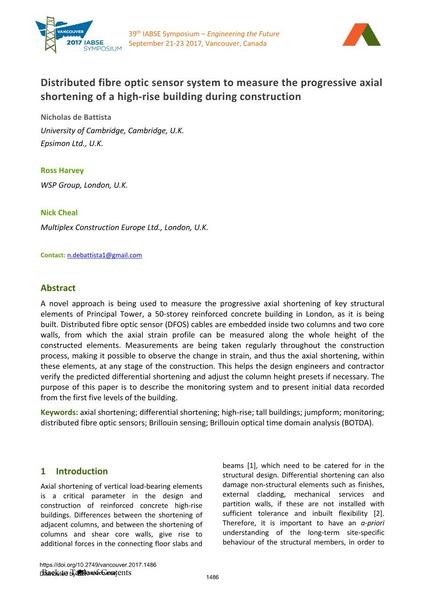Distributed fibre optic sensor system to measure the progressive axial shortening of a high-rise building during construction

|
|
|||||||||||
Bibliografische Angaben
| Autor(en): |
Nicholas de Battista
(University of Cambridge, Cambridge, U.K. Epsimon Ltd., U.K.)
Ross Harvey (WSP Group, London, U.K.) Nick Cheal (Multiplex Construction Europe Ltd., London, U.K.) |
||||
|---|---|---|---|---|---|
| Medium: | Tagungsbeitrag | ||||
| Sprache(n): | Englisch | ||||
| Tagung: | IABSE Symposium: Engineering the Future, Vancouver, Canada, 21-23 September 2017 | ||||
| Veröffentlicht in: | IABSE Symposium Vancouver 2017 | ||||
|
|||||
| Seite(n): | 1486-1493 | ||||
| Anzahl der Seiten (im PDF): | 8 | ||||
| Jahr: | 2017 | ||||
| DOI: | 10.2749/vancouver.2017.1486 | ||||
| Abstrakt: |
A novel approach is being used to measure the progressive axial shortening of key structural elements of Principal Tower, a 50-storey reinforced concrete building in London, as it is being built. Distributed fibre optic sensor (DFOS) cables are embedded inside two columns and two core walls, from which the axial strain profile can be measured along the whole height of the constructed elements. Measurements are being taken regularly throughout the construction process, making it possible to observe the change in strain, and thus the axial shortening, within these elements, at any stage of the construction. This helps the design engineers and contractor verify the predicted differential shortening and adjust the column height presets if necessary. The purpose of this paper is to describe the monitoring system and to present initial data recorded from the first five levels of the building. |
||||
| Stichwörter: |
Monitoring
|
||||
